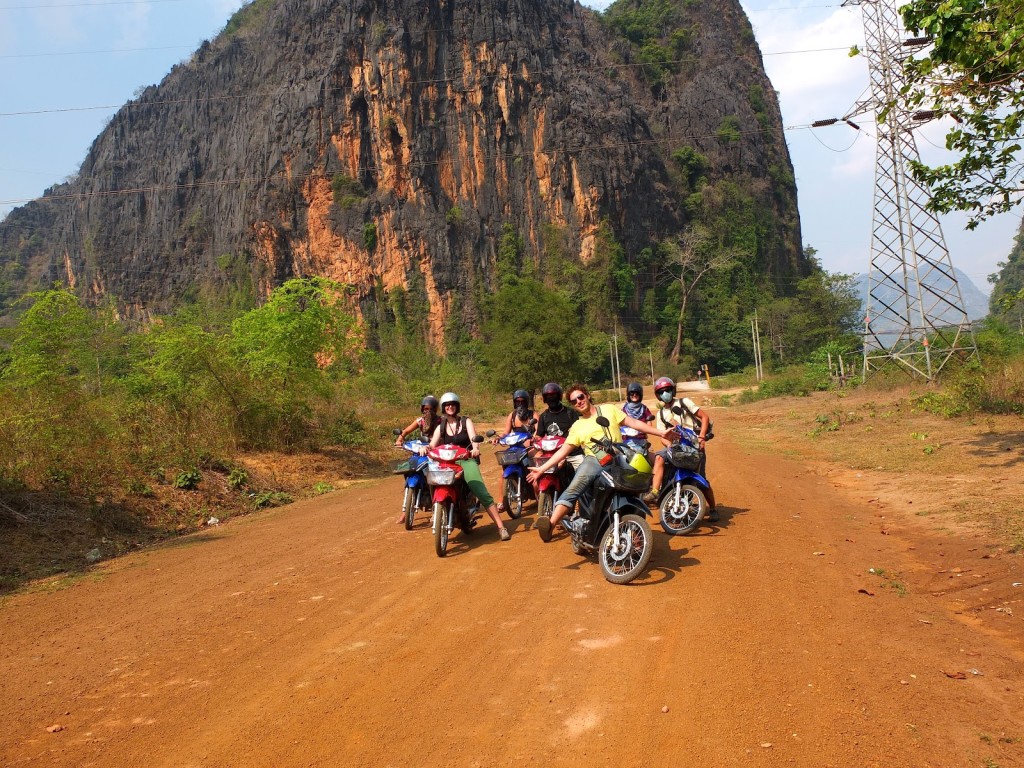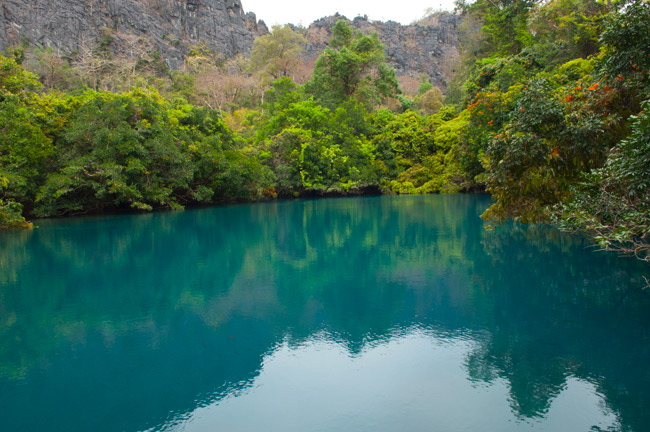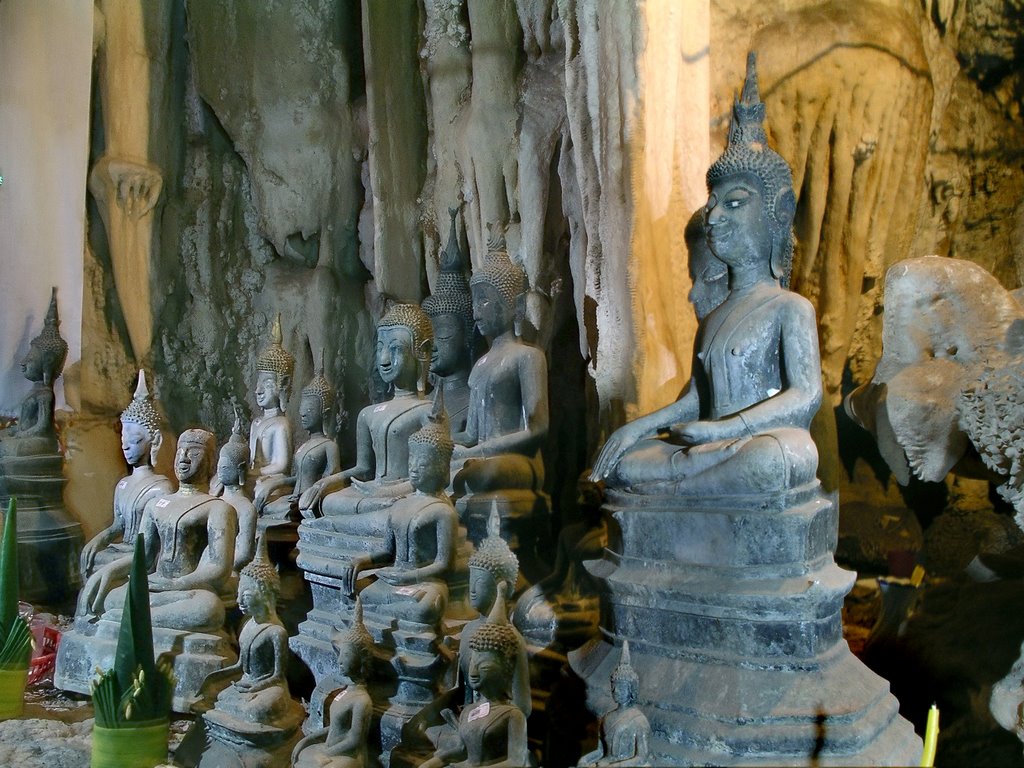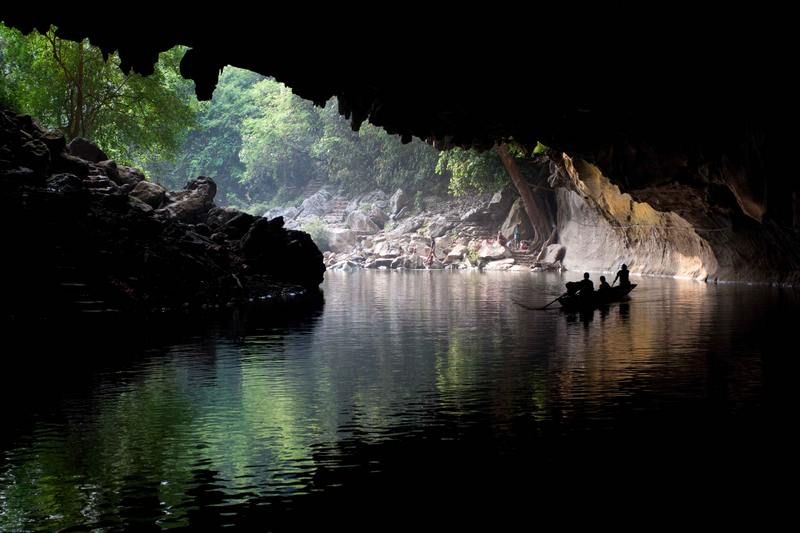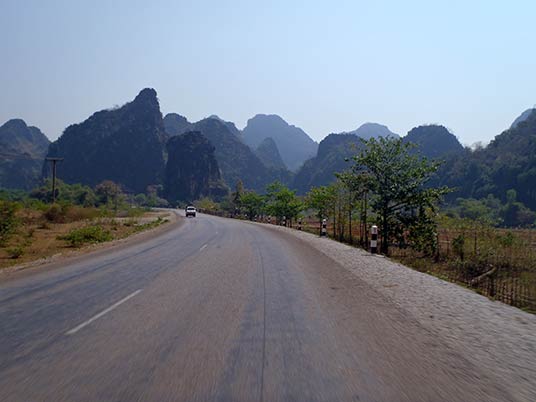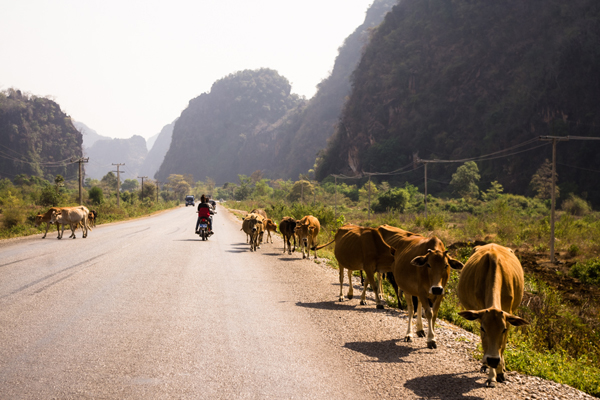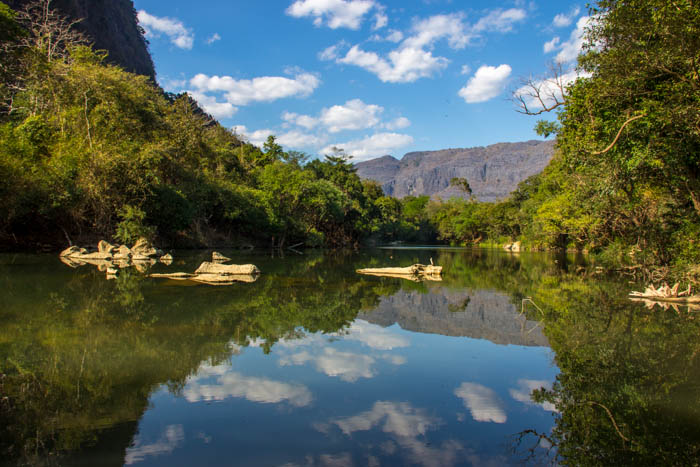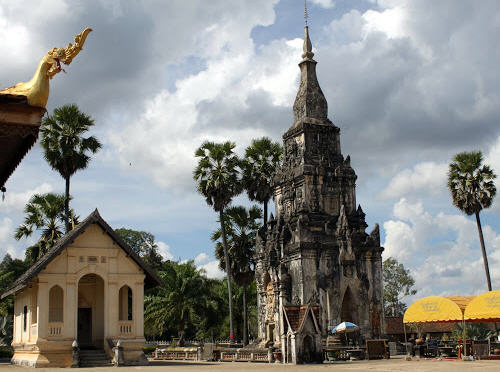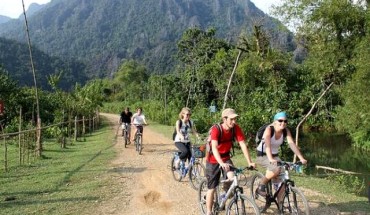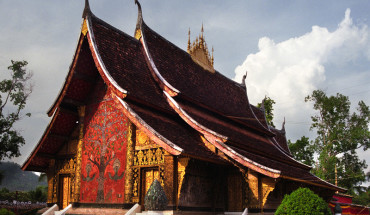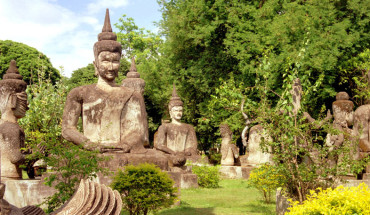The central provinces of Laos, sandwiched between the Mekong (and Thailand) to the west and the Annamite Mountains (and Vietnam) to the east, are the least visited in the country, which is a shame as the scenery here is stunning, with dramatic limestone karsts, enormous caves, beautiful rivers and forests.
In particular, the upland areas to the east, off Route 8 and Route 12, in Khammouane and Bolikhamxai Province, are a veritable treasure trove of attractions, mottled with scores of caves, lagoons, rivers and rock formations. Visitors will require some determination in these parts, as the infrastructure is still being developed. The Mekong towns of Thakhek and Savannakhet are elegant and relaxed and are the main transport and tourist hubs in the region. Pakse is the optimum place to base yourself to explore the central provinces.
Thakhek and around
Located on the Mekong, at the junction of Routes 13 and 12, Thakhek is a quiet town, surrounded by beautiful countryside. It is the capital of Khammouane Province and was founded in 1911 -1912, under the French. Apart from Luang Prabang, Thakhek is probably the most outwardly French-looking town in Laos, with fading pastel villas clustered around a simple fountain area. It has a fine collection of colonial-era shophouses, a breezy riverside position and a relaxed ambience. One of Laos’ holiest sites, That Sikhot, the stunning caves of the region and beautiful Mahaxai can all be visited from here. This town is the most popular stopover point in the central provinces, attracting a range of tourists with its vast array of caves, rivers, lakes and other attractions. Despite encompassing some of the most beautiful scenery in Laos – imposing jagged mountains, bottle green rivers, lakes and caves – the region is still not considered a primary tourist destination. Tourism infrastructure is still quite limited but is improving and a trip to this area will prove the highlight of most visitors’ holidays to Laos.
Arriving in Thakhek
Getting there There are two bus terminals: the main terminal is about 4 km from town and offers inter-provincial and international buses, and the small songthaew station, near Soksombook market, which services local regions.
Getting around Thakhek is small enough to negotiate on foot or by bicycle. A number of places organize motorbike hire, such as the Thakhek Travel Lodge and the Tourism Information Centre, which acts as an agent for motorcycle dealers.
That Sikhot
That Sikhot or Sikhotaboun is one of Laos’ holiest sites. It overlooks the Mekong and the journey downstream from Thakhek, along a quiet road, reveals bucolic Laos at its best. That is thought to have been built by Chao Anou at the beginning of the 15th century and houses the relics of Chao Sikhot, a local hero, who founded the old town of Thakhek.
According to local legend, Sikhot was bestowed with Herculean strength after eating some rice he had stirred with dirty – but as it turned out, magic – sticks. At that time, the King of Vientiane was having a problem with elephants killing villagers and taking over the country (hard to believe now but Laos was once called Land of a Million Elephants). The king offered anyone who could save the region half his kingdom and his daughter’s hand in marriage. Due to his new-found strength, Sikhot was able to take on the pachyderms and secure most of the surrounding area as well as Vientiane, whereupon he married the King of Vientiane’s daughter. The king was unhappy about handing over his kingdom and daughter to this man, and plotted with his daughter to regain control. Sikhot foolishly revealed to his new wife that he could only be killed through his anus, so the King of Vientiane placed an archer at the bottom of Sikhot’s pit latrine and when the unfortunate Oriental Hercules came to relieve himself, he was killed by an arrow.
That Sikhot consists of a large gold stupa raised 29 m on a plinth, with a viharn upstream built in 1970 by the last King of Laos. A major annual festival is held here in July and during February.
Kong Leng Lake
This site is usually incorporated into hikes as there isn’t direct road access to the lake. Steeped in legend, locals believe an underground kingdom lies beneath the surface of the 100-m-deep lake. As a result, you must request permission to swim here from the local village authority and you can only swim in the designated swimming zone. Fishing is not permitted. The beautiful green waters of the lake morph into different shades season to season due to the dissolved calcium from the surrounding limestone crops. It is very difficult to get to on your own and the track is sometimes completely inaccessible except on foot. The Tourism Information Centre organizes excellent treks to the lake.
Tham Pha (Buddha Cave)
Ban Na Khangxang, off Route 12,18km from Thakhek. Women will need to hire a sinh (sarong) at the entrance.
A farmer hunting for bats accidentally stumbled across the Buddha Cave (also known as Tham Pa Fa, or ‘Turtle Cave’) in April 2004. On climbing up to the cave’s mouth, he found 229 bronze Buddha statues, believed to be more than 450 years old, and ancient palm leaf scripts. These Buddhas were part of the royal collection believed to have been hidden here when the Thais ransacked Vientiane. Since its discovery, the cave has become widely celebrated, attracting pilgrims from as far away as Thailand, particularly around Pi Mai (Lao New Year). A wooden ladder and eyesore concrete steps have now been built to access the cave, but it is quite difficult to get to as the dirt road from Thakhek is in poor condition.
It is recommended that you organize a guide through the Thakhek Tourism Information Centre, to escort you. In the wet season, it is necessary to catch a boat. The journey itself is half the fun as the cave is surrounded by some truly stunning karst formations sprawling across the landscape like giant dinosaur teeth.
Tham Kong Lor (Kong Lor Cave)
Tham Kong Lor Cave can only be described as sensational. The Nam Hinboun River has tunnelled through the mountain, creating a giant rocky cavern, 6 km long, 90 m wide and 100 m high, which opens out into the blinding bright light at Ban Natan on the other side. The cave is apparently named after the drum makers who were believed to make their instruments here. Although very rare, it is also home to the largest living cave-dwelling spiders in the world, though it is unlikely you will have a run in with the massive arachnid. Fisherman often comes into the cave to try their luck as it is believed that 20-kg fish lurk below the surface.
At the start of the cave, you will have to scramble over some boulders while the boatmen carry the canoe over the rapids, so wear comfortable shoes with a good grip. A torch or, better, a head-lamp, is also recommended. It is eerie travelling through the dark, cool cave, with water splashing and bats circulating. The cave can also be visited as part of the 400-km ‘loop’ from Thakhek.
The best way to get there is by road and boat. There is a small transport terminus at the Route 13/Route 8 intersection in Ban Lao (also known as Tham Beng or Vieng Kham) for north-south buses between Vientiane and Pakse. Songthaew generally pass through here from early in the morning to well into the afternoon to Ban Na Hin. This trip along Route 8 is about 60 km. The drive between Ban Lao and Ban Na Hin is magical and passes through some truly amazing Gothic scenery; keep an eye out for the lookout at Km 54 from Route 13. Generally, a pick-up waits in Ban Na Hin to take passengers to Ban Kong Lor, where you can pick up a boat trip into the cave. There is also one public songthaew a day.
Alternatively, if the new road is flooded you can get a songthaew, as far as Ban Napur, or Na Phouak, and then catch a boat to Ban Phonyang, two to three hours, or Ban Kong Lor (closer to the cave), and onto the cave, a further one hour.
If you are staying at Sala Hin Boun, for a fee they can arrange to collect you from Ban Napur.
Route 12 and the ‘Loop’ in Laos
Contact Thakhek Travel Lodge for details of the ‘loop’ route and for motorbike hire. MrKu who rents the motorbikes is based at the lodge. Mr Ku has contacts around the Loop. He recommends riders take 3days. He will help out in an emergency and advises on no-go times (for example, in Sep and Oct during the rains).
The impressive karst landscape of the Mahaxai area is visible to the northeast of town and can be explored on a popular motorbike tour from Thakhek, known as the Loop, which runs from Thakhek along Route 12 to Mahaxai, then north to Lak Sao, west along Route 8 to Ban Na Hin and then south back to Thakhek on Route 13, taking in caves and other beautiful scenery along the way. The circuit should take approximately three days but allow four to five, particularly if you want to sidetrack to Tham Kong Lor and the other caves.
The ‘Loop’ is mostly for motorcyclists, who pick up a bike in Thakhek and travel by road. The whole loop covers an area over 400 km (without the side-trips). This includes 50 km from Thakhek to the petrol station before the turn-off to Mahaxai; 45 km between the petrol station and Nakai; 75 km between Nakai and Lak Xao; 58 km between Lak Xao and 380-Laos Central provinces Ban Na Hin; 41 km between Ban Na Hin and Ban Lao and then 105 km between Ban Lao and Thakhek. The trip between Ban Lao and Ban Na Hin offers some spectacular views.
If travelling by motorbike pack light: include a waterproof jacket, a torch, a few snacks, a long-sleeved shirt, sunglasses, sun block, closed-toe shoes, a sinh or sarong (to use as a towel, to stop dust and – for women – to bathe along the way), a phrase book and a good map. It is a bumpy, exhausting but enjoyable ride. All of the sites are now well signposted in English. Most sites charge a parking fee for motorbikes.
Note that this whole region is susceptible to change due to the operation of the Nam Theun II dam, a US$1.5 billion hydropower project, and other developments in the area. It is imperative that you check for up-to-date information before travelling.
The caves along Route 12 can also be visited on day trips from Thakhek, although some are difficult to find without a guide and access may be limited in the wet season. Many of the sights have no English signposts but locals will be more than obliging to confirm you are going in the right direction if you ask. Turn south off Route 12 at Km 7 to reach Tham Xang (Tham Pha Ban Tham), an important Buddhist shrine that contains some statues and a box of religious scripts. It is considered auspicious due to the ‘elephant head’ that has formed from calcium deposits and in the Lao New Year the locals sprinkle water on it. At Km 13, turn north on a track for 2 km to Tha Falang (Vang Santiphap or ‘Peace Pool’), a lovely emerald billabong on the Nam Don River, surrounded by pristine wilderness and breathtaking cliffs. It’s a nice place to spend the afternoon or break your journey. In the wet season it may be necessary to catch a boat from the Xieng Liab Bridge to get here. Turn south off Route 12 at Km 14 and follow the track south to reach Tham Xiang Liab, a reasonably large cave at the foot of a 300-m-high limestone cliff, with a small swimming hole (in the dry season) at the far end. It is not easy to access the interior of the cavern on your own and, in the wet season, it can only be navigated by boat, as it usually floods. This cave, called ‘sneaking around cave’ derived its name from a legend of an old hermit who used to meditate in the cave with his beautiful daughter. A novice monk fell in love with the hermit’s daughter and the two lovebirds planned their trysts sneakily around this cave and Tham Nan Aen. When the hermit found out he flew into a rage and did away with the novice monk; the daughter was banished to the cave for the rest of her life.
At Km 17, beyond the narrow pass, turn to the north and follow the path for 400 m to reach Tham Sa Pha In, a cave with a small lake and a couple of interesting Buddhist shrines. Swimming in the lake is strictly prohibited as the auspicious waters are believed to have magical powers.
South of Route 12, at Km 18, a path leads 700 m to the entrance of Tham Nan Aen. This is the giant of the local caverns at 1.5 km long and over 100 m high. It has multiple chambers and the entrances are illuminated by fluorescent lighting; it also contains a small underground freshwater pool.
Green Climbers Home 2 km east of Thakek, www.greenclimbershome.com, open Oct-May, is an absolute heaven for seasoned climbers and those who want to learn. 10 bungalows and two dorm rooms set among some breathtaking karsts scenery.
Savannakhet
Situated on the banks of the Mekong at the start of Route 9 to Danang in Vietnam, Savannakhet or Savan as it is usually known – is an important river port and gateway to the south. The city has a sizeable Chinese population and attracts merchants from both Vietnam and Thailand, while the ubiquitous colonial houses and fading shop fronts is an ever-present reminder of earlier French influence. In 2010 authorities recognized the value of its historic core and 30 billion kip is to be spent on preserving the colonial-era architecture. Savannakhet Province has several natural attractions, although the majority is a fair hike from the provincial capital. For those short on time in Laos, Pakse makes a better stopover than Savannakhet.
Arriving in Savannakhet
Getting there and around Flights on Lao Airlines run from Vientiane, Pakse and Bangkok to Savannakhet. It is possible to cross into Vietnam by taking Route 9 easts over the Annamite Mountains via Xepon. The border is at Dansavanh (Laos) and Lao Bao (Vietnam), 236 km east of Savannakhet, with bus connections direct from Savannakhet to Danang, Dong Ha and Hue. It is possible to cross the border into Thailand near Mukdahan via the new Friendship Bridge. The government bus terminal is near the Savan Xai market has connections with Vientiane, Thakhek, Pakse and Lao Bao.
Just west of the bus station is the songthaew terminal, where vehicles depart to provincial destinations. Tuk-tuks, locally known as Sakaylab, criss-cross town.
Places in Savannakhet
Savan’s colonial heritage can be seen throughout the town centre. Perhaps-the most attractive area is the square and church east of the former immigration office between Khanthabouli and Phetsalath roads. Wat Sounantha has a three-dimensional raised relief on the front of the sim, showing the Buddha in the mudra of bestowing peace, separating two warring armies. Wat Sayaphum on the Mekong is rather more attractive and has several early 20th-century monastery buildings. It is both the largest and oldest monastery in town, although it was only built at the end of the 19th century. Evidence of Savan’s diverse population is reflected in the Chua Dieu Giac, a Mahayana Buddhist pagoda that serves the town’s Vietnamese population. The Dinosaur Museum Khanthabouli Rd, houses a collection of four different dinosaur and early mammalian remains, and even some fragments of a meteorite that fell to earth over 100 million years ago.
The Provincial Museum Khanthabouli Rd, offers plenty of propaganda-style displays but little that is terribly enlightening unless you are interested in the former revolutionary leader Kaysone Phomvihane.
That Inheng
Any of the regular tuk-tuks will make the trip return, or take a shared songthaew to Xeno and ask to hop off at That Inheng. They will usually take you all the way there but if they drop you at the turning it is only a 3-km walk. Alternatively hire a bicycle in town and cycle. This holy 16th-century that or stupa is 12 km northeast of Savannakhet and is the second-holiest site in Southern Laos after Wat Phou. It was built during the reign of King Sikhottabong at the same time as That Luang in Vientiane, although local guides may try to convince you it was founded by the Indian emperor Asoka over 2000 years ago. Needless to say, there is no historical evidence to substantiate this claim. The wat is the site of an annual festival at the end of November akin to the one celebrated at Wat Phou, Champasak.
Dong Phou Vieng National Protected Area
The Savannakhet Eco Guide Unit, runs excellent treks through the Dong Phou Vieng National Protected Area, home to wildlife such as Siamese crocodiles, Asian elephants, the endangered Eld’s deer, langurs and wild bison (most of which you would be incredibly lucky to see). Located within the NPA is a Song Sa Kae (Sacred Forest and Cemetery), revered by the local Katang ethnic group, who are known for their buffalo sacrifices. The well-trained local guides show how traditional natural produce is gathered for medicinal, fuel or other purposes. The tours are exceptionally good value and home stay is included. Most only run during the dry season.
You may be interested in Laos Tours


